樸素貝葉斯趣味挑戰項目
1.目的
定時爬取笑話網站,利用樸素貝葉斯分析,將不同笑話發給不同人群。
2.方案
(1)首先利用python爬蟲抓取某個網站上的笑話。
(2)之後利用windows系統的任務計劃程序功能早上8點定時執行此python爬蟲。因為不可能一直開著電腦,所以用雲服務器。
(3)然後用樸素貝葉斯模型來判斷當前的笑話是否屬於成人笑話。
(4)如果是成人笑話,用爬蟲把它自動發給好兄弟的qq郵箱。
(5)如果不是成人笑話,用爬蟲把它自動發給女朋友的qq郵箱。
3.實施
1.選取合適的笑話網站。---- 某某網站。
2.學習爬蟲,本來只會RSS源那樣子爬,但是好多網站找不到RSS地址,所以我只能學習爬蟲。
(其實最後也沒用到抓包工具,可以先不下載)首先需要抓包工具,下載火狐瀏覽器的低版本才能兼容httpfox,下載地址http://ftp.mozilla.org/pub/firefox/releases/35.0/win32/zh-CN/,這個是中文版
首先入門爬蟲,https://cuiqingcai.com/1052.html,學長推薦的課程,開始入門。
這門課程上的是Python2,關於其中的函數的差別,http://blog.csdn.net/duxu24/article/details/77414298
首先以post的方式爬取一個不需要驗證碼的
import urllib.requestimport urllib.parse values = {"username":"[email protected]","password":"xxxxx"} data = urllib.parse.urlencode(values).encode(‘utf-8‘) url = "http://nian.so/" request = urllib.request.Request(url,data) response = urllib.request.urlopen(request) print(response.read())
3.記錄一下cookie學習的代碼。
1)利用CookieJar對象實現獲取cookie的功能,並存儲到變量中,打印變量。
import urllib.request import urllib.parse import urllib.error import http.cookiejar cookie = http.cookiejar.CookieJar() #聲明一個CookieJar對象實例來保存cookie #使用HTTPCookieProcessor創建cookie處理器,並以其為參數構建opener對象 handler = urllib.request.HTTPCookieProcessor(cookie) opener = urllib.request.build_opener(handler) #構建請求 respoense = opener.open("http://www.baidu.com") for item in cookie: print(‘Name = ‘,item.name) print(‘Value = ‘,item.value)
2)保存Cookie到文件,用MozillaCookieJar模塊
import urllib.request import urllib.parse import urllib.error import http.cookiejar filename = "F:\\cookie.txt" cookie = http.cookiejar.MozillaCookieJar(filename) #聲明一個CookieJar對象實例來保存cookie #使用HTTPCookieProcessor創建cookie處理器,並以其為參數構建opener對象 handler = urllib.request.HTTPCookieProcessor(cookie) opener = urllib.request.build_opener(handler) #構建請求 respoense = opener.open("http://www.baidu.com") #保存cookie到文件 cookie.save(ignore_discard=True,ignore_expires=True)
ignore_discard的意思是即使cookies將被丟棄也將它保存下來,ignore_expires的意思是如果在該文件中cookies已經存在,則覆蓋原文件寫入。
打開cookie文件。

3)從文件中獲取Cookie並訪問
import urllib.request import http.cookiejar filename = "F:\\cookie.txt" cookie = http.cookiejar.MozillaCookieJar() #聲明一個CookieJar對象實例來保存cookie #使用HTTPCookieProcessor創建cookie處理器,並以其為參數構建opener對象 cookie.load(filename,ignore_discard=True,ignore_expires=True) request = urllib.request.Request("http://www.baidu.com") handler = urllib.request.HTTPCookieProcessor(cookie) opener = urllib.request.build_opener(handler) #構建請求 response = opener.open(request) print(response.readline())
4)利用cookie模擬網站登錄
訪問我校教務系統。
import urllib.request import http.cookiejar filename = "F:\\cookie.txt" cookie = http.cookiejar.MozillaCookieJar(filename) #聲明一個CookieJar對象實例來保存cookie #使用HTTPCookieProcessor創建cookie處理器,並以其為參數構建opener對象 handler = urllib.request.HTTPCookieProcessor(cookie) opener = urllib.request.build_opener(handler) #構建請求 loginUrl = "http://ids.chd.edu.cn/authserver/login?service=http%3A%2F%2Fportal.chd.edu.cn%2F" values = {"username":"201524070201","password":"xxxxxx"} data = urllib.parse.urlencode(values).encode(‘utf-8‘) respoense = opener.open(loginUrl,data) #保存cookie到文件 cookie.save(ignore_discard=True,ignore_expires=True) gradeUrl = "http://bkjw.chd.edu.cn/eams/teach/grade/course/person!search.action?semesterId=75&projectType=" result = opener.open(gradeUrl) print(result.read())
4.記錄正則表達式學習過程中的一點小問題。
我把學習正則的python文件命名為re.py,結果說module ‘re‘ has no attribute ‘match‘,結果一百度
命名py腳本時,不要與python預留字,模塊名等相同,即Python文件名不要使用Python系統庫的名字,就是因為使用了Python系統庫的名字,
所以在編譯的時候才會產生.pyc文件。正常的Python文件在編譯運行的時候是不會產生.pyc文件的!
這類問題的解決方法則是:更改python腳本的命名,不要與python系統庫重合即可。回答鏈接:https://www.cnblogs.com/fangxx/p/xx-python02.html
5.正式學習爬取某笑話網站。
學習崔慶才大神的爬取記錄,還有後人更改py2為py3的博客,進行學習。
1)目標。
(1)抓取糗事百科熱門段子。
(2)過濾袋有圖片的段子。
(3)根據發布時間,段子內容,點贊數,進行篩選。
2)確定URL並抓取頁面代碼。
import urllib.request import urllib.error #不需要用到cookie #構建請求 page = 1 url = "https://www.qiushibaike.com/hot/page/" + str(page) header = { "User-Agent": "Mozilla/5.0 (Windows NT 10.0; Win64; x64) AppleWebKit/537.36 (KHTML, like Gecko) Chrome/58.0.3029.96 Safari/537.36" } try: request = urllib.request.Request(url,headers=header) response = urllib.request.urlopen(request) print(response.read().decode("utf-8")) except urllib.error.URLError as e: if hasattr(e,"code"): print(e.code) if hasattr(e,"reason"): print(e.reason)
提取到的內容如圖所示。
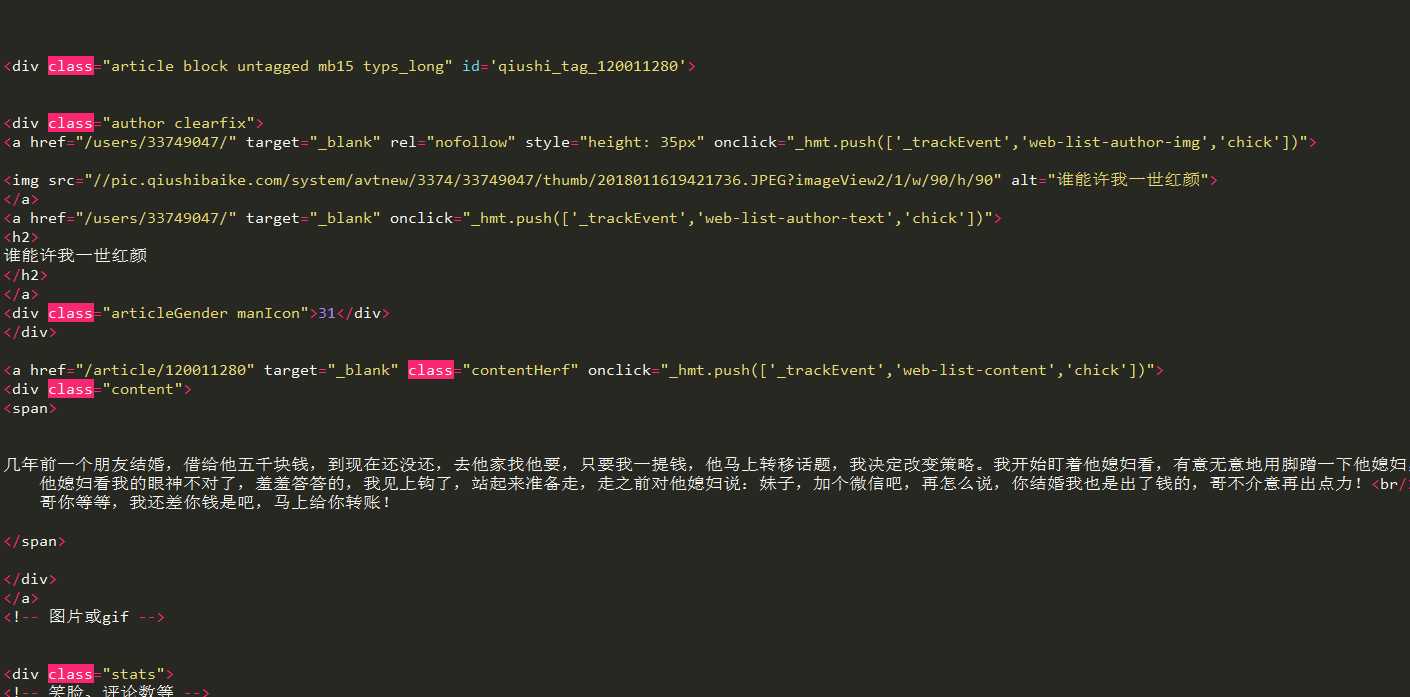
3)加入正則表達式提取第一頁的所有段子。
先寫正則表達式。
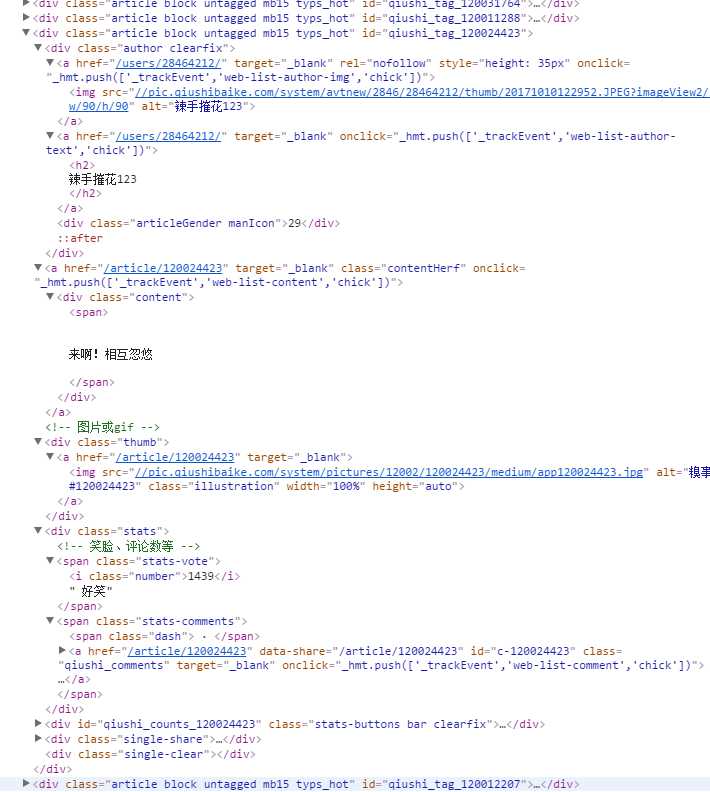
正則表達式如下:
#0發布人 1內容 2是圖片 3是點贊數 pattern = re.compile(‘‘‘<div class="article.*?<h2>(.*?)</h2>.*?‘‘‘ + ‘‘‘<span>(.*?)</span>.*?‘‘‘ + ‘‘‘<!-- 圖片或gif -->(.*?)<div class="stats">.*?‘‘‘ + ‘‘‘<span class="stats-vote"><i class="number">(.*?)</i>‘‘‘, re.S)
正則表達式在寫的時候,一定要註意空格!!! <!-- 圖片或gif --> 裏面的空格害我找了很長時間。
4)獲取笑話。
過濾掉帶圖片的。
import urllib.request import urllib.error import re def init(): #不需要用到cookie #構建請求 page = 1 url = "https://www.qiushibaike.com/hot/page/" + str(page) header = { "User-Agent": "Mozilla/5.0 (Windows NT 10.0; Win64; x64) AppleWebKit/537.36 (KHTML, like Gecko) Chrome/58.0.3029.96 Safari/537.36" } try: request = urllib.request.Request(url,headers=header) response = urllib.request.urlopen(request) content = response.read().decode("utf-8") #0發布人 1內容 2是圖片 3是點贊數 pattern = re.compile(‘‘‘<div class="article.*?<h2>(.*?)</h2>.*?‘‘‘ + ‘‘‘<span>(.*?)</span>.*?‘‘‘ + ‘‘‘<!-- 圖片或gif -->(.*?)<div class="stats">.*?‘‘‘ + ‘‘‘<span class="stats-vote"><i class="number">(.*?)</i>‘‘‘, re.S) items = re.findall(pattern,content) #只要沒圖片的段子 for item in items: if not re.search("img",item[2]): result = re.sub(‘<br/>‘,"\n",item[1]) print("發布人: %s\n內容:%s\n點贊數:%s\n" %(item[0].strip(),item[1].strip(),item[3].strip())) except urllib.error.URLError as e: if hasattr(e,"code"): print(e.code) if hasattr(e,"reason"): print(e.reason) init() #<div class="content">
把那種查看全文的顯示全。

獲取段子完整代碼。其中遇到的問題:http://www.cnblogs.com/littlepear/p/8456897.html
import urllib.request import urllib.error import re page = 5 url = "https://www.qiushibaike.com/hot/page/" mainurl = "https://www.qiushibaike.com" header = { "User-Agent": "Mozilla/5.0 (Windows NT 10.0; Win64; x64) AppleWebKit/537.36 (KHTML, like Gecko) Chrome/58.0.3029.96 Safari/537.36" } def init(): content = getpage(index = page) #0發布人 1內容 2是圖片 3是點贊數 pattern = re.compile(‘‘‘<div class="article.*?<h2>(.*?)</h2>.*?‘‘‘ + ‘‘‘<a href="(.*?)".*?‘‘‘ + ‘‘‘<span>(.*?)</span>.*?‘‘‘ + ‘‘‘<!-- 圖片或gif -->(.*?)<div class="stats">.*?‘‘‘ + ‘‘‘<span class="stats-vote"><i class="number">(.*?)</i>‘‘‘, re.S) items = re.finditer(pattern,content) pageItems = [] #只要沒圖片的段子 for item in items: zannum = int(item.group(5).strip()) if ((not re.search("img",item.group(4))) and (zannum>1000)): #print(zannum) 挑選贊大於1000的笑話 #print(item.group()) if ((not re.search("查看全文",item.group()))): result = re.sub("<br/>","\n",item.group(3)) #print("發布人: %s\n內容:%s\n點贊數:%s\n" %(item.group(1).strip(),result.strip(),item.group(5).strip())) pageItems.append([item.group(1).strip(),result.strip(),item.group(5).strip()]) else: contentForAll = getpage(contentUrl=item.group(2)) patternForAll = re.compile(‘‘‘<div class="article.*?<h2>(.*?)</h2>.*?‘‘‘ + ‘‘‘<div class="content">(.*?)</div>.*?‘‘‘ + ‘‘‘<span class="stats-vote"><i class="number">(.*?)</i>‘‘‘,re.S) # patternForAll = re.compile(‘‘‘<div class="article.*?<h2>(.*?)</h2>‘‘‘ # + ‘‘‘.*?<div class="content">(.*?)</div>‘‘‘ # + ‘‘‘.*?<i class="number">(.*?)</i>‘‘‘, re.S) newitems = re.findall(patternForAll,contentForAll) result = re.sub("<br/>","\n",newitems[0][1]) #print("發布人: %s\n內容:%s\n點贊數:%s\n" %(newitems[0][0].strip(),result.strip(),newitems[0][2].strip())) pageItems.append([newitems[0][0].strip(),result.strip(),newitems[0][2].strip()]) return pageItems def getpage(index=None,contentUrl=None): response = None if index: request = urllib.request.Request(url + str(index),headers=header) response = urllib.request.urlopen(request) elif contentUrl: request = urllib.request.Request(mainurl + contentUrl,headers=header) response = urllib.request.urlopen(request) return response.read().decode("utf-8") def main(): pageItems = [] pageItems = init() for jokelist in pageItems: for content in jokelist: print(content) main()
效果:
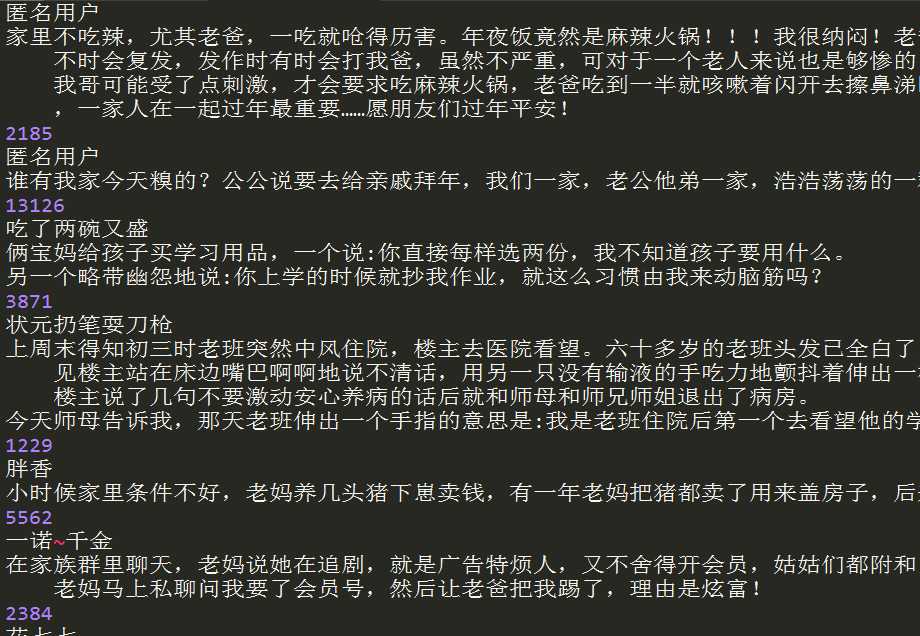
6.通過樸素貝葉斯判斷是成人笑話還是普通笑話。
用了一份停用表,感覺效果還很好。
之前與之後的對比:

關於樸素貝葉斯的寫法與推導,在之前的博客上:http://www.cnblogs.com/littlepear/p/8322251.html
同時關於漢字的處理,參考:https://www.cnblogs.com/marc01in/p/4775440.html
from numpy import * #加載停用詞 stop_word = [] def loadword(text): word = [] fr = open(text,‘r‘) lines = fr.readlines() for line in lines: word.extend(line.strip()) fr.close() return word def bagOfWordsVec(vocabSet,inputSet): returnVec = [0]*len(vocabSet) for word in inputSet: if word in vocabSet: returnVec[vocabSet.index(word)] += 1 return returnVec def textParse(bigString,stop_word): listOfWord = [] #print(stop_word) for word in bigString: if word not in stop_word: listOfWord.append(word) return listOfWord #創建一個詞匯的集合 def createVocabList(dataSet): vocabSet = set([]) #創建空集合 for document in dataSet: vocabSet |= set(document) return list(vocabSet) def trainNB0(trainMatrix,trainCategory): numTrainDocs = len(trainMatrix) #有幾行話 numWords = len(trainMatrix[0]) #每行的詞匯表的詞數 # print(numTrainDocs) # print(numWords) pAbusive = sum(trainCategory)/float(numTrainDocs) #p(Ci) 算是垃圾郵件的概率 p0Num = ones(numWords) p1Num = ones(numWords) # print(p0Num) #p0Denom = 2.0; p1Denom = 2.0 #書上是2.0 不知道為什麽 p(x1|c1)= (n1 + 1) / (n + N) 看網上的, #為了湊成概率和是1,N應該是numWords p0Denom = 1.0*numWords; p1Denom = 1.0*numWords for i in range(numTrainDocs): if trainCategory[i] == 1: #某句話是侮辱性的話 p1Num += trainMatrix[i] #矩陣相加 #print(p1Num) p1Denom += sum(trainMatrix[i]) #print(p1Denom) else: p0Num += trainMatrix[i] p0Denom += sum(trainMatrix[i]) p1Vect = log(p1Num/p1Denom) p0Vect = log(p0Num/p0Denom) return p0Vect,p1Vect,pAbusive def classifyNB(vecOClassify,p0Vec,p1Vec,p1Class): p1 = sum(vecOClassify*p1Vec) + log(p1Class) p0 = sum(vecOClassify*p0Vec) + log(1 - p1Class) if p1 > p0: return 1 else: return 0 #進行測試 def jokeTest(): stop_word = loadword(‘stopword1.txt‘) docList = [];classList = [] for i in range(1,26): text = (‘joke/adult/%d.txt‘ % i) wordList = loadword(text) wordList = textParse(wordList,stop_word) docList.append(wordList) classList.append(1) text = (‘joke/normal/%d.txt‘ % i) wordList = loadword(text) wordList = textParse(wordList,stop_word) docList.append(wordList) classList.append(0) vocabList = createVocabList(docList) # 40個訓練集,10個測試集 trainingSet = list(range(50));testSet = [] for i in range(10): randIndex = int(random.uniform(0, len(trainingSet))) testSet.append(trainingSet[randIndex]) #保證隨機性,不管重復 del(trainingSet[randIndex]) trainMax = []; trainClasses = [] for docIndex in trainingSet: #print(docIndex) trainMax.append(bagOfWordsVec(vocabList, docList[docIndex])) trainClasses.append(classList[docIndex]) p0V,p1V,pSpam = trainNB0(array(trainMax),array(trainClasses)) errorCount = 0 for docIndex in testSet: wordVector = bagOfWordsVec(vocabList, docList[docIndex]) if classifyNB(array(wordVector), p0V, p1V, pSpam) != classList[docIndex]: errorCount += 1 print("the text %s \n the result %s the true result %s " % (docList[docIndex],classifyNB(array(wordVector), p0V, p1V, pSpam),classList[docIndex])) print("error rate: %f " % (float(errorCount)/len(testSet))) # def main(): # stop_word = [] # stop_word = loadword(‘stopword.txt‘) # for item in stop_word: # print(item) #main() jokeTest()
50個樣例采用交叉驗證的方法,40個訓練,10個測試,錯誤率在10%左右。
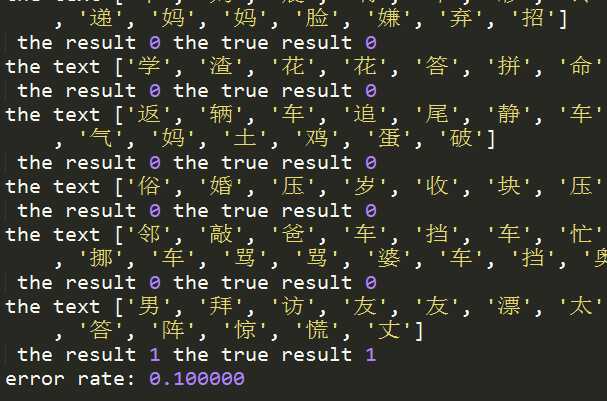
7.通過qq郵箱發送郵件
參考:https://www.cnblogs.com/xshan/p/7954317.html
import smtplib from email.mime.text import MIMEText from email.utils import formataddr my_sender=‘[email protected]‘ # 發件人郵箱賬號 my_pass = ‘xxxxxxxxx‘ # 發件人郵箱密碼(當時申請smtp給的口令) my_user=‘[email protected]‘ # 收件人郵箱賬號 def mail(): ret=True try: content = "I love you!" msg=MIMEText(content,‘plain‘,‘utf-8‘) msg[‘From‘]=formataddr(["發件人昵稱",my_sender]) # 括號裏的對應發件人郵箱昵稱、發件人郵箱賬號 msg[‘To‘]=formataddr(["收件人昵稱",my_user]) # 括號裏的對應收件人郵箱昵稱、收件人郵箱賬號 msg[‘Subject‘]="郵件主題-測試" # 郵件的主題,也可以說是標題 server=smtplib.SMTP_SSL("smtp.qq.com", 465) # 發件人郵箱中的SMTP服務器,端口是465 server.login(my_sender, my_pass) # 括號中對應的是發件人郵箱賬號、郵箱密碼 server.sendmail(my_sender,[my_user,],msg.as_string()) # 括號中對應的是發件人郵箱賬號、收件人郵箱賬號、發送郵件 server.quit()# 關閉連接 except Exception:# 如果 try 中的語句沒有執行,則會執行下面的 ret=False ret=False return ret ret=mail() if ret: print("郵件發送成功") else: print("郵件發送失敗")
8.整合
所有代碼稍後給個github上的鏈接:
以下是正常笑話:
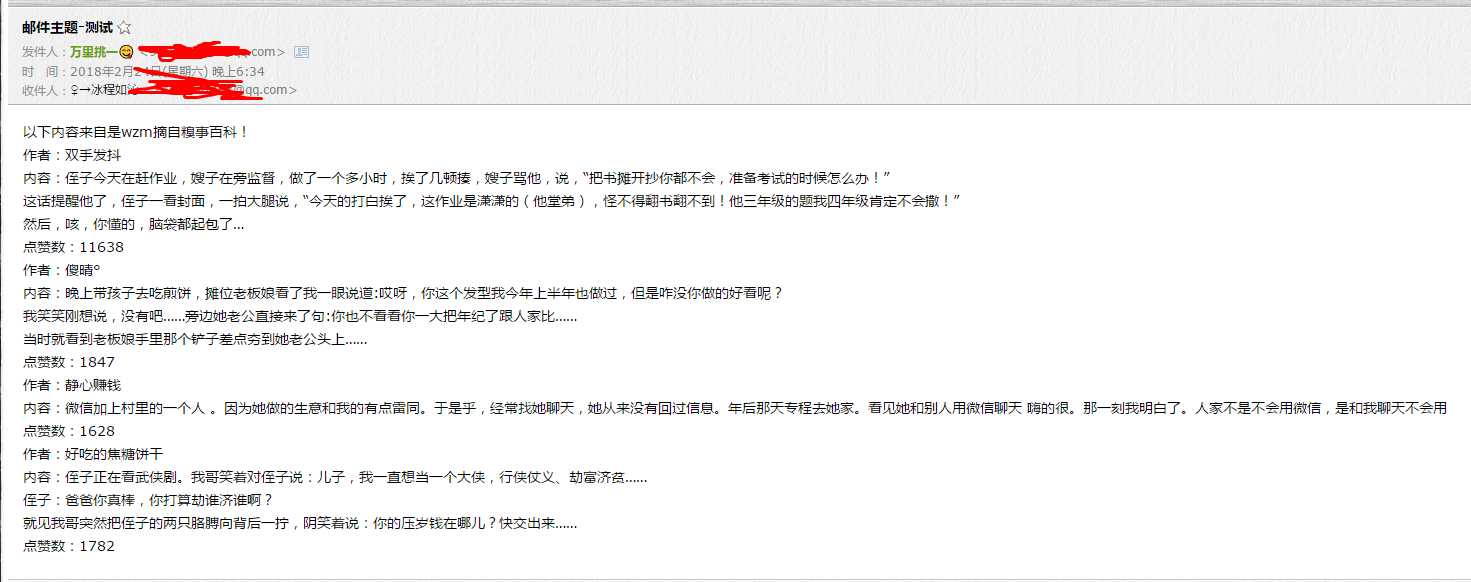
以下是成人笑話:
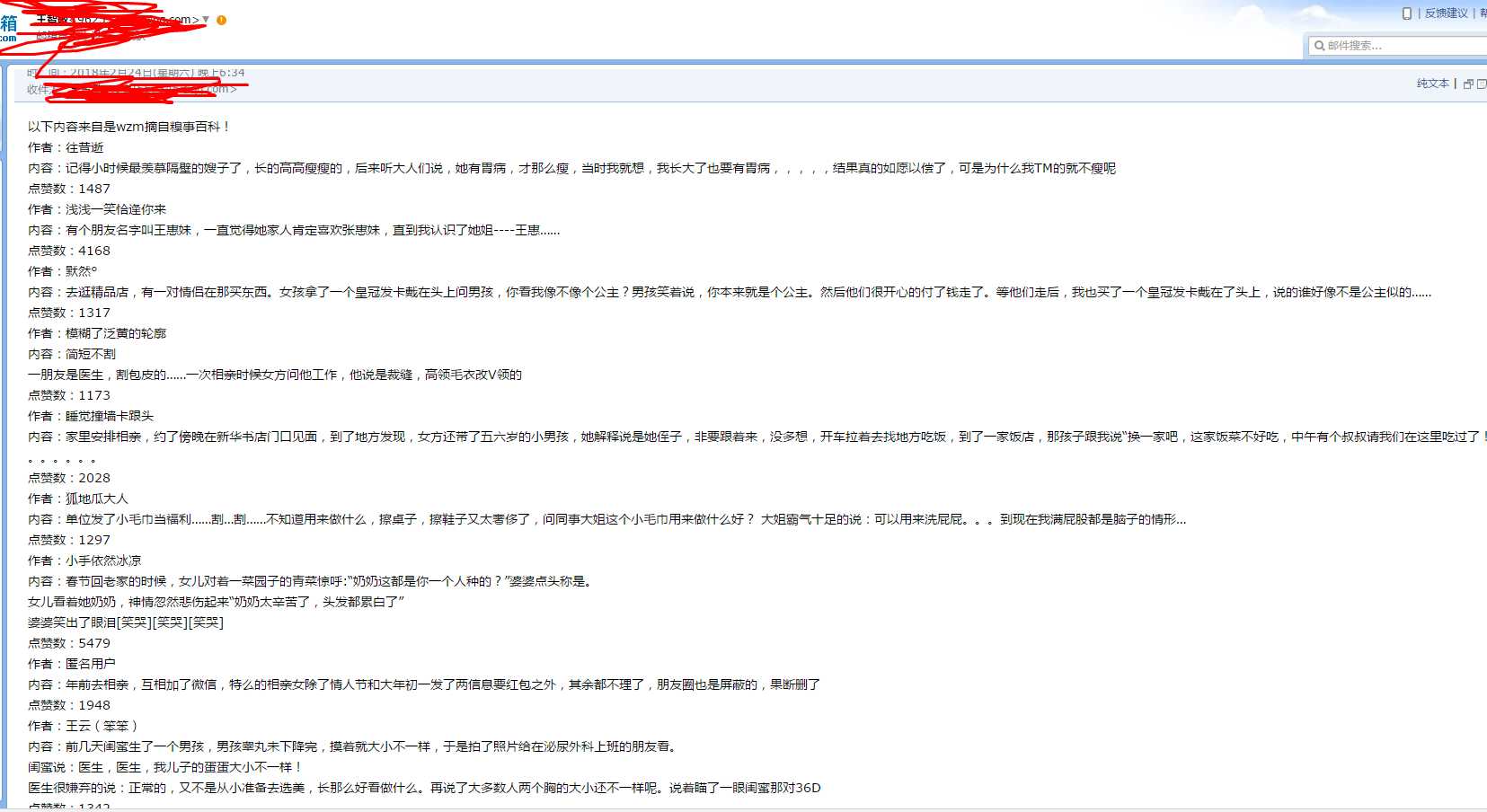
樸素貝葉斯趣味挑戰項目
